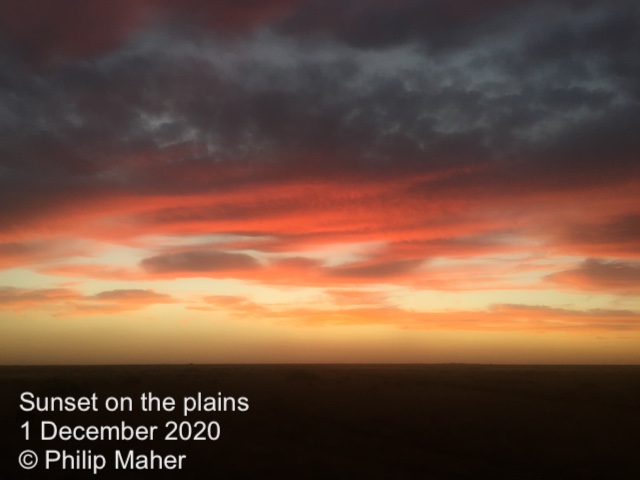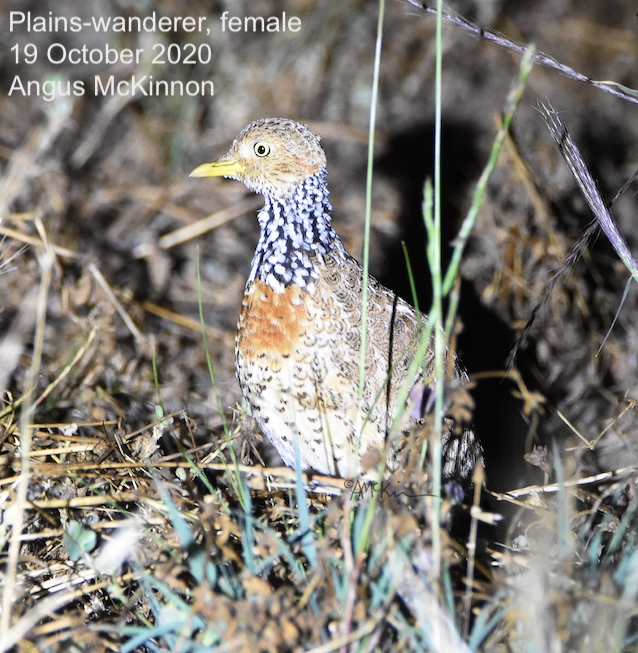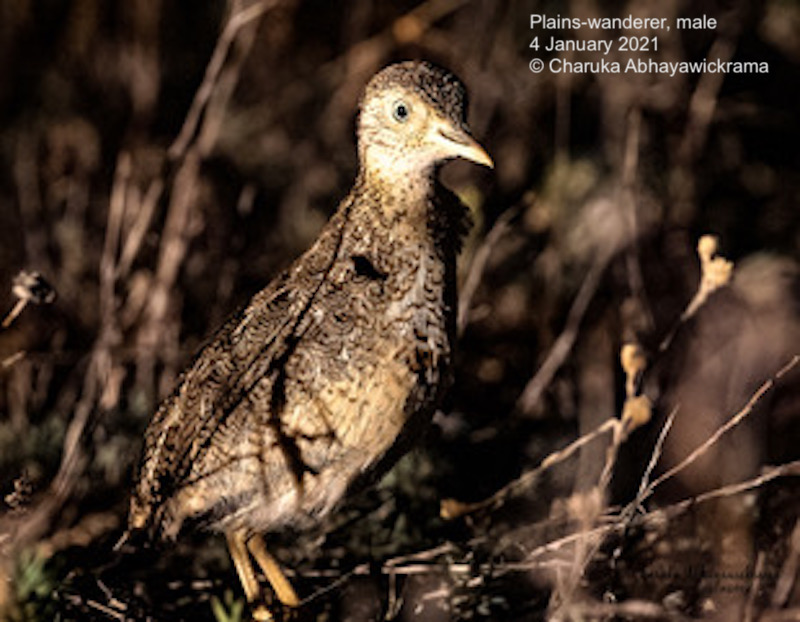Plains-wanderer Report 2020
Plains-wanderer Report 2020
Climatic Conditions
The three-year drought finally broke in 2020. Most of the district apart from the Gulpa/Mathoura area received a little above average rainfall. However, due to the previous three-year period being the driest recorded in European history for the Murray/Darling catchment, it has meant that much of the country has still not fully recovered, despite the above average rainfall.Rainfall figures for the Deniliquin District in 2020 from south to north.
Gulpa revegetation area 370 mm (442 mm long-term average for Mathoura ~ 13 km south of Gulpa)
Deniliquin (our house): 453 mm (400 mm long-term average for Deniliquin)
Monimail revegetation area Hay Road: 431 mm (long-term average roughly 375 mm)
Wanganella revegetation area: 438 mm (366 mm long term average for Zara station ~ 12 km WNW)
John’s house on the plains-wanderer property 379 mm (350 mm long-term average).
The Gulpa area was the only area where I measured below average rainfall in 2020. This Gulpa area has for most of the last fifteen years — since I have been recording it — received less rainfall than the long-term average.The standout months in 2020 were March and April when Deniliquin recorded over 200 mm of rain — half the year’s average in just two months. In a twenty-four hour period on 4 and 5 March I recorded 100 mm of rain in my gauge in Deniliquin. By 30 April 2020, Deniliquin had received more rain than all of 2019 — 250 mm vs 235 mm. The other standout months were August and October with 50 mm or more recorded for most localities.
Some of the other formerly reliable winter rainfall months, such as June and July, were disappointing with mainly well-below average rainfall. Likewise, September, November and December were mostly well-below average. If some of those months had produced good rainfall it would have been a fantastic year.
Out on the plains, John on the plains-wanderer property had been missing some of the earlier rain but July, August and October proved more productive with 28 mm, 57 mm and 34 mm recorded respectively. The country was still looking quite bleak in September and it was not until the October rain that it really started to recover and the plains-wanderers finally settled in.
Plains-wanderers in 2020
The year started off okay with an adult female seen on outings on 6 and 11 January — probably the same bird. After that things went decidedly pear-shaped when no plains-wanderers could be found in late February or early March. Although there was still a bit of cover in the main paddock that we had been finding them in, I believe it became too dry for them at that time and they cleared out. There weren't many left at this stage at any rate. There had been virtually no sheep in the main paddock for about four years.While we traditionally see very few visiting birders from mid-summer until spring, by March 2020, Covid 19 had rendered travel difficult for everyone, so we had little incentive to go out looking for plains-wanderers. However, I am fairly certain there were few if any plains-wanderers left in the district at that stage as most of the plains country was largely devoid of ground cover.
Robert and I went out on a reconnaissance at the end of May to a negative result. The country was still too bare at that stage despite all the rain that had fallen in March and April. The ground was so dry after three years of drought that almost nothing had grown. We didn’t venture out again until September when we had some birders coming. We did reconnaissance missions on 8 and 11 of September but were again unable to find a plains-wanderer. On 13 September I took out my first clients for the spring; despite a long search, a plains-wanderer could not be found. We were worried.
We had also tried listening for the calls at dusk in September but heard only ravenous mosquitoes, except for one occasion when Robert did hear a female call. We went back a couple of times and never heard her again.
On 27 September I took out Del from the Coffs Harbour area. (A few NSW birders were venturing out of lockdown by this stage.) I warned Del that we didn't have much chance for plains-wanderer as our last three searches had proved fruitless, but she wanted to give it a go. Del, just when she was realising the enormity of the task, got lucky when a male plains-wanderer took off near us and landed a short distance away. This was the first plains-wanderer we had seen since 11 January. Except for the female Robert heard in September, they had been absent for eight and a half months.
We found another female plains-wanderer in a different paddock on 10 October after looking in the paddock where Del and I had seen the male in late September. On 13 October I took out some more clients but was unable to find a plains-wanderer at either location. We were also getting a lot of wind at this time, making it impossible to listen for calls at dusk. Back to square one ...
It seemed that the plains-wanderers were coming in but not settling in to breed as they normally would. The ground cover was still quite patchy at this stage but there was some good rain in October that thickened the cover up in some paddocks at least. On 17 October, Robert flushed a female plains-wanderer in the daytime while he was moving sheep. This proved to be our breakthrough moment for finally getting onto some breeding birds.
We did a reconnaissance a couple of days later and heard the female call at dusk and found her shortly afterwards. We did not have another miss for the rest of the year. There were at least two trios of plains-wanderesr in this locality — one female mates with two males.
A mating pair was seen on 24 October and a nest with four eggs on 14 November. On 28 November, two different males were seen in the general vicinity of where the nest was, both with chicks in tow. At this stage we were starting to find them in other paddocks; it was apparent more birds had arrived in October.
We also found them back where Del and I had the original sighting in September. We finished up finding plains-wanderers in four different paddocks although only a fairly low number of birds were involved.
In all during 2020, we had 37 sightings of adult plains-wanderers plus maybe five chicks between the two males. We undertook 24 excursions including the four reconnaissance trips. Many of these sightings were of the same birds and I suspect we probably had at least six trios of plains-wanderer attempting to breed in the spring and early summer of 2020. We probably saw around twenty individual plains-wanderer in 2020 plus the chicks.
Oddly, this is about the same number of trios that were present in 2019 — which only received about half the rainfall of 2020. I think this reflects just how low their numbers are after the three driest years ever recorded in r the Murray/ Darling catchment — since records began.
I expect their breeding success was a lot better in 2020 than it was in 2019. Strangely, not a single immature bird was seen up to year’s end and, while only conjecture, I suspect the adults were kicking the immatures out of the area where we had seen the chicks as some adults seemed keen to breed again. This is in contrast to 2019 when quite a few immature birds turned up in November, birds that had been bred outside the area.
As plains-wanderers were late turning up this season, and with the good rain in October and another 22 mm of rain in December, I suspect that perhaps quite a few birds were still breeding towards the end of the year. Fingers crossed, we could find many immature birds in the new year.
Grazing by kangaroos
Although the paddock we were finding them in had no sheep in it, it was continuously grazed by a large mob of red kangaroos. Kangaroos are well-known to favour grazing in paddocks that have no sheep in them, which makes it problematic when sheep grazing is removed from a paddock.At the end of 2020, after all the rain we had had, it turned out that the paddock that had near enough to no sheep grazing in it for around four years was the paddock that had the least amount and diversity of grass in it. I put this down to it being almost continuously grazed by a mob of red kangaroos. I believe a similar problem has arisen on Oolambeyan National Park.
Plains-wanderers did eventually settle back in this paddock but were mostly living in Calocephalus sonderi, a strong smelling herb that is shunned by both sheep and kangaroos. Red kangaroos are primarily grass-eaters and usually avoid most species of herbs.
Acknowledgements
John and Glenys Nevinson and a nine-year old Robert and his sister Sandra were with me when we found our first plains-wanderer. August 2020 marked the fortieth anniversary of that event. That Robert, John and I are still looking for plains-wanderers is nothing less than extraordinary. That we’ve shown around 8000 birders a plains-wanderer or two is remarkable. That they put up with me is incomprehensible. Trisha and I thank them for a life we could never have envisaged forty years ago.
Statistics 2020
Plains-wanderer sightings 2020 Number of PW excursions in 2020 Number of PW successful excursions wth clients in 2020 Number of PW successful excursions wth clients in spring/early summer 2020 Number of clients in 2020 37 21 + 5 reconnaissance or incidental records 17/21 19/21 64 Statistics 2019
Plains-
wanderer sightings
2019Number of PW excursions in
2019Number of PW successful excursions wth clients in 2019 Number of PW successful excursions
wth clients in spring/early summer
2019
Number of clients in 2019 65 37 + 3 reconnaissance or incidental records 35/37 35/35 188
Philip Maher
enquiries@philipmaher.com
www.philipmaher.com

